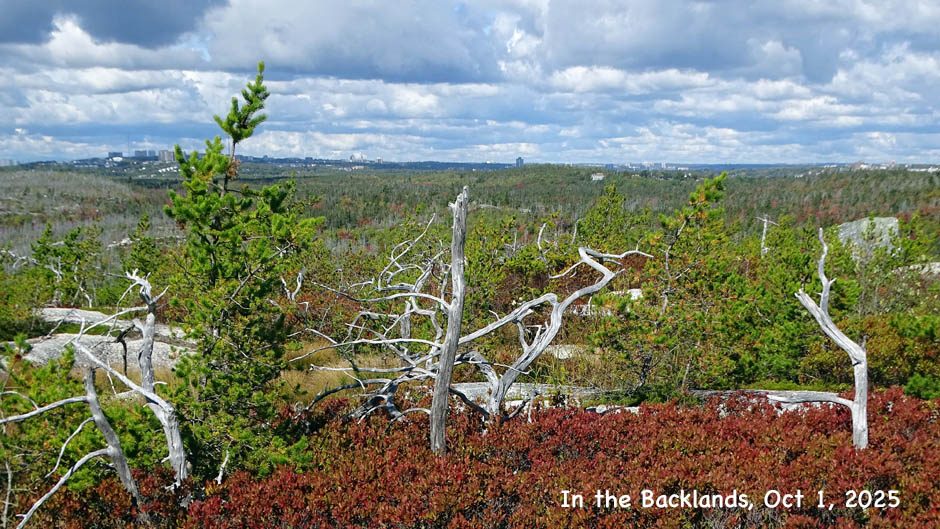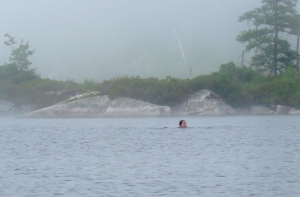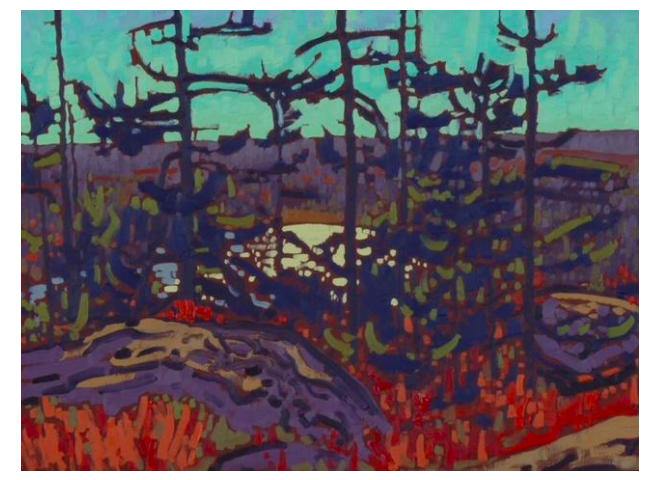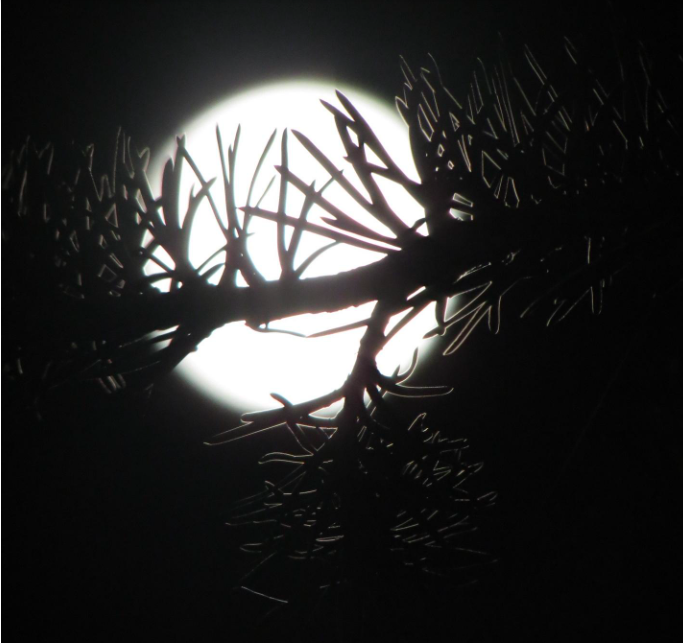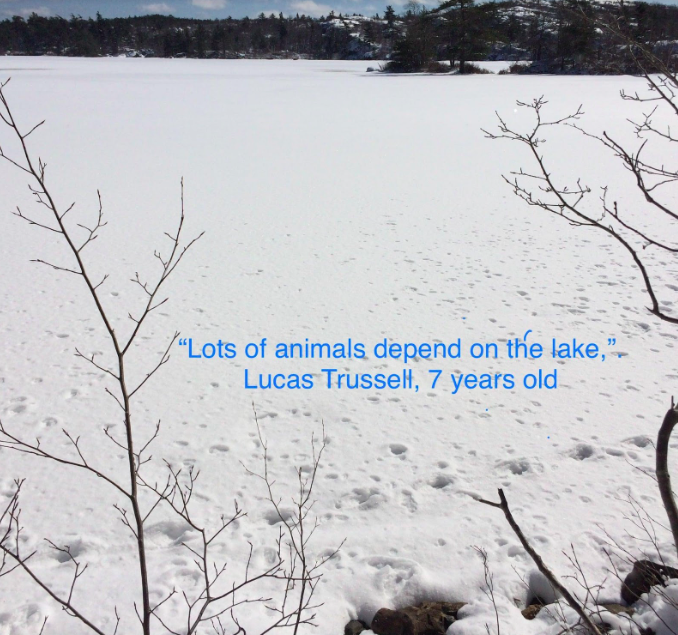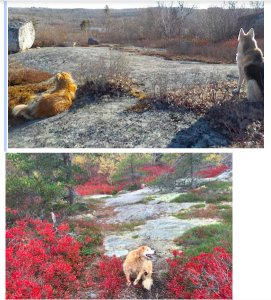 Thoughts from a house on Purcells Cove Road
Thoughts from a house on Purcells Cove Road
Purcells Cove Backlands
By Paula Musial
For thirty years I’ve walked out my back door and up into the woods connecting immediately to the deer trails in the Purcells Cove Backlands. The last 16 have been with my two dogs; Grace and Elsa. Every day and never one the same. Each season has its treasures. The girls and I love going off trail to explore mammoth cliffs and rocks, the local wildlife and flora and fauna unique to this area. The views are pretty good too. This little piece of Heaven right in a city is precious. The positive energy it gives off is so beneficial to the human spirit. Years ago you would hardly see anyone on the paths past Purcell’s Pond and Williams Lake and Colpitt Lake but times have changed. The young families crave and demand healthier lifestyles and do make use of all the new trails. All of the animals, insects and Trees Trees Trees want to stay too!
Chris Field, Halifax (Fall, 2022)
My family has had a very long connection with the Backlands. In 1921, my grandfather, Captain J. C. Arnell bought 35 acres on which he built a summer cottage. The land includes part of Purcells Pond and goes back to Flat Lake. Starting in 1947 when my parents immigrated from England, through to the mid 1950’s my brothers and I spent many happy summer days clambering up the granite slope behind our cottage, climbing up on the Peach Stone and swimming in Purcells Pond. During the sixties, my parents and my younger brothers continued to explore and enjoy the Backlands. As we sat on the top enjoying the magnificent vistas in the peace and quiet of the natural world around us, we realized what a magical place the Backlands are.
In the seventies, my brother Nick and his family bought the cottage with its building lot but my mother retained the title to the Backlands part of the property (33 acres in all). In 2003 she decided to deed the property to the seven Field boys, Chris, Roger, Nick, Nigel, Kenneth, Peter and Rob. We quickly realized that we all felt it was very important to preserve our property as it is so it could continue to be enjoyed by all the local residents for whom it was a place to hike and then cool off in the lovely clear waters of Purcells Pond. We met with Bonnie Sutherland of the Nova Scotia Nature Trust about donating our land to them and calling it the Captain Arnell Conservation Land. We celebrated our donation in 2005 with the press and many at the Social Club. I rather suspect it was the only time the seven of us had completely agreed on anything. Bonnie was very excited to have their first “urban” park which is accessible to so many people. The Napier family followed our example and donated their adjacent property.
I receive great pleasure in knowing that my grandchildren and my brother’s grandchildren will be able to enjoy the backlands as we all did growing up. Hearing the warblers sing as a sure sign of spring, the blue jays calling loudly and the swallows hunting insects as they have done for the millennia reminds me the value of the urban Backlands in providing a sanctuary where the stress of everyday life just falls off our shoulders and we emerge refreshed and re-vitalized.
Childhood Memories of Williams Lake and the Backlands by Iris (Umlah) Shea
October, 2022
My mother moved to Jollimore in 1908 when she was four years old. Her family had been swimming in Williams Lake and exploring the area around it since they were children. My memories go back to the 1940s when my mother and her sisters continued their annual family picnics and berry picking.
My memories of picking blueberries on an annual basis at Williams Lake and McIntosh Run begin during the 1940s, a family tradition my mother’s family started decades earlier. During the 1920s my mother’s brother built a fishing and hunting camp on the Brunt property at McIntosh Run. An elder sister had married a Brunt, the owner of the land, currently present day Princeton Avenue. In their teenage years my mother and two of her sisters hitched up their father’s horse and wagon and made the trip from their home in Jollimore, along the William’s Lake Road and the Herring Cove Road to visit their sister, Annie Brunt, stay over night at their brother’s camp, and spend a weekend picking blueberries.
In the 1940s an all day outing for me was the annual blueberry picking event on a Saturday in August. My mother, my two aunts, my brothers, and sometimes a cousin or two, would walk from Jollimore along Williams Lake Road to catch the Herring Cove bus to the Brunt family farm. In addition to blueberry picking, it was also an opportunity for my mother and her sisters to visit their aging sister and her family, the Brunts. Their farm occupied both sides of the Herring Cove at Princeton Avenue. My brother and I were fascinated by the cows roaming in the large grassy fields, and by the trout that my aunt kept in her well, always the same trout each year according to my aunt.
Before noon we headed through the woods to McIntosh Run, past the remnants of my uncle’s old fishing and hunting camp. There was always a rowboat on the shore to row across the Run to the blueberry barrens . In a large clearing near the shore the adults set up supplies and equipment for eating and swimming. We had time for a swim before lunch but after lunch the afternoon was spent climbing over the rocks in search of the blueberry bushes.
I recall the panoramic views of our natural surroundings, looking down over lakes in the distance. There were no housing developments off in the distance, no traffic sounds, only the sound of birds and squirrels as we picked our berries. One of my aunts always managed to stepped on an ants’ nest, creating some entertainment for the rest of us. Huckleberries were also eaten in abundance while we searched for blueberries. A tall baking powder tin was used to collect the blueberries and, when full, the berries were poured into a large covered pot carried by an adult. We took a break part way through the afternoon for tea over a campfire, another swim in the Run, and back to picking blueberries until it was time eat again. Both meals were the same, cold slices of homemade meatloaf, potato salad, tomato and lettuce from our garden, and homemade apple or rhubarb pie for dessert. Before rowing back across McIntosh Run the blueberries were divided equally among the adults to be made into jam, blueberry grunt and blueberry pies. There was just enough time to say goodbye to my Brunt relatives before boarding the bus to Williams Lake Road. Laden with buckets of berries, exhausted after a busy but fun-filled day in the sun, we walked along the Williams Lake Road to our respective homes in Jollimore.
Annual Picnics at Williams Lake
My mother moved to Jollimore in 1908 when she was four years old. Her family had been swimming in Williams Lake and exploring the area around it since they were children. My memories go back to the 1940s when my mother and her sisters continued their annual family picnics and berry picking.
My brother, Greg, and I looked forward to these events each year. We loved that Saturday in early July when we walked from our home in Jollimore, through the woods to the Boscobel Gates, and along the Purcell’s Cove Road to Pine Needle Path (known locally as the Ice Road) in Boulderwood. At the foot of Pine Needle Path, just before the rocky shore of the lake, was a clearing under tall pine trees. The tablecloth was set up on layers of pine needles and water was boiled for tea in a pot over an open fire. Following our swim we sat on the towel-covered pine needles to eat our cold slices of homemade meatloaf, potato salad, and rhubarb or apple pie for dessert. Another swim followed by a second meal (a repeat of the first one) brought our day to an end before dark. My two older brothers had participated in the event in previous years, always an all day event. The morning and afternoon swim were memorable but our picnic lunch and evening meal after our swims were even more memorable.
Picking Berries at Williams Lake
Picking cranberries and foxberries in the Fall of each year was an event my mother and aunts had been doing for many years, dating back to when they were children. The cranberry bogs were not far from the dam at the end of Williams lake. In the 1940s and 1950s we could still use the old “rocky road” off the Purcell’s Cove Road, the original road used for over 150 years by the mill workers in order to access the dam. That road has since been absorbed by the nearby property. Cranberries were picked in late September and early October, and foxberries were picked about two or three weeks later. More than one visit was usually required to make sure we picked all of the ripened berries. Lunch on those days consisted of egg sandwiches, home made cookies and a thermos of tea. We also picked cranberries around Martin’s Pond, off the Williams Lake Road, where Cunard Junior High is located today. We usually had wet feet going home.
Just Like Having a Cottage
By: Claire McIntyre
A lake to splash in, rocky cliffs to scale, blueberries to pick, nature to explore, life-lessons to learn – feels like we’re at the cottage.
We didn’t have a cottage when I grew up in the Williams Lake area. The lake was our cottage, a rich environment of lessons and laughs that shaped my childhood.
The Shaw Wilderness Park and Williams Lake are like cottage country to me, right here in Halifax – a walk, bike or bus away for most of our HRM residents. HRM invests in playgrounds, tennis courts, sports facilities, soccer fields and other aspects of our city’s environment. It is just as important to invest in protecting and rehabilitating our natural environment. I believe that the payoff for these investments could be even greater because of how many people benefit now and for years to come. Most importantly, our fragile ecosystem benefits from a healthy, functioning environment as well.
Living close to the Shaw Wilderness Park, a favourite thing I used to like to do was jump off the huge rocks into the deep lake waters in a little cove across from the Williams Lake dam. I needed to work up the courage to jump into the unknown and learned to push through my fear. The jump was always a highlight of our summer play.
We also anticipated blueberry season when berries were ripe and we could spend hours picking and tasting. It was an adventure. We felt so wild and free to forage in the natural tundra, around the lake, often in bare feet and eating berries until we were “blue in the face.”
Skating on the lake was a magical, winter experience because I loved being able to explore the entire lake from a different perspective. Seeing the beaver dams close up, viewing huge rock piles, hearing streams flowing into the lake, but the hockey games were the best! We enjoyed the winter because we were outdoors playing, exploring and learning.
When I think about “amenities” I want to live with, I think about the woods, lakes, ocean and natural spaces to play, explore, learn and just be in. I think it is important that these natural spaces are accessible to all people.
My partner also grew up in Spryfield and he has fond memories of biking in the woods near Colpitt Lake with friends. Jumping streams, anticipating the next rock drop, inhaling the forest, the rush of the speed were the adventure. Such freedom we had! We value this part of Halifax so much we wanted to start our family here. Luckily we have been able to.
 I’ve been taking my daughter out on walks in nature since she was born. In these early days of childhood, we have a lot of responsibility to be our kids’ playmates and playing their games all day is a lot! Going outside, I feel like we have more space and opportunity to appreciate our time together.
I’ve been taking my daughter out on walks in nature since she was born. In these early days of childhood, we have a lot of responsibility to be our kids’ playmates and playing their games all day is a lot! Going outside, I feel like we have more space and opportunity to appreciate our time together.
Having the opportunity and privilege to spend time in and around the Shaw Wilderness Park makes parenting easier and rewarding for me. I teach my daughter about plants, birds and wild life that live around us. Our experiences outside have contributed to her development, physically and mentally. During these Covid times, being outside is one of the healthiest and safest things we can do for our children, spouses, families and friends.
The lake and the park have been a life saver! As a mum with small kids, I thrive off time with family and other friends raising children – so a good walk and explore in the Shaw Wilderness Park, especially during Covid times does wonders for all of us.
Birding in the Backlands
By Joshua Barss Donham, 2021
Helping Fulton Lavender with the bird survey in the Backlands:
Conducting a bird survey with Fulton in the Backlands is done as much by ear as it is by sight. In early August we visited three locations in The Purcells Cove Backlands. Two of the locations originated at the ridge overlooking two lakes and the lowland through which the Macintosh Run weaves. This is a dramatic landscape of exposed rock scraped clean by glaciers, punctuated by glacial erratic, enormous rocks left by the receding ice sheets during the last ice age, and interspersed with Jack Pine.
As we walked, we stopped frequently while Futon stretched his ears listening for the voices of birds. Every species has its own particular songs, and to Fulton’s ear each is as distinct as the melody of a favourite song is to us. At that time of year, however, many birds we heard had recently fledged, “teenagers” Fulton likes calling them; learning by mimicking their parents, they hadn’t got it quite right yet. We saw and heard dozens of species in the course of the morning.
The first place we visit, just after sunrise, was East Island Lake Pond – a large body of water with several small rock islands edged by thick wood on one side and with bare rock sloping to the water’s edge on the other. After making notes on the species we saw and heard, we linger for a while at the edge of the pond in the early morning light and listen to the reedy, ethereal songs of hermit thrush floating across the pond from the far shore.
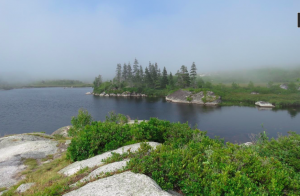 East Pine Island swimming
East Pine Island swimming
Joshua Barss Donham
November 2022
Here are a few photos from the East Pine Island swimming spot including a couple of Marie swimming on a hazy August day. On the rocks across the inlet that is the swimming spot there is a nice large jack pine that survived the 2009 fire among the spruce. The innermost section of the inlet, where it is just a few feet deep, has water lilies growing in it where damselflies like to perch.
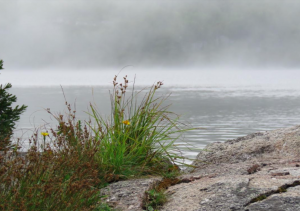
Hal Bent experiences the Backlands
The Halifax Backlands are a place of natural beauty with many hidden gems for those willing to explore. Most people visiting there would not be aware of the geological, natural, and historical significance to be experienced throughout the area. From the prisoner’s cave in the
north to Piggy’s Mountain in the south. From the historical Queen’s Quarry workings in the east and the provincially recognized mountain bike trails in the west. The Backlands has a lot to offer.
read More (PDF)
Geoffrey Grantham
As an urban wilderness, the Backlands is an important area, both ecologically and recreationally.
As an artist who paints landscapes out of doors, this area has been very important to me and for the progression of my work. I have been creating art in the Backlands for 18 years and have built a career in doing so. I consider the large body of work that I’ve created in this area to be my greatest accomplishment.
It is my hope that in preserving the Backlands, future generations will be afforded opportunities such as the one that has enriched my life far beyond a monetary value.
The Backlands is a special place.
Some examples of my work are shown here.
Geoffrey Grantham September 2022
The Hunter’s Moon – Joshua Barss Donham
8 October 2022

This evening my daughter, Rosa, who spied the magnificent moon, suggested we take a drive to a spot where we could see it better. The Hunter’s Moon, also called the Migrating Moon by the Cree referring to the full moon at the time when the birds begin heading south* illuminates the needles of a Jack Pine at the edge of the Purcell’s Cove Backlands.
And Jack Pines illuminated by the last lonely street light at the end of Alabaster Way, a street light that shares its pole with an Osprey’s nest on the high ridge overlooking the Backlands.
.
* The Farmer’s Almanac
“Lots of animals depend on the lake”
Lucas Trussell, 7 years old
“The other day I walked my dog Wally in the Backlands and we both ate handfuls of blueberries and blackberries” Stuart Inglis, August 2022

The definition of awesomeness?
Being in the Backlands with friends pre-dawn and just before the sun rises in a heavy mist, hearing the birds waking up. Vireos, robins, song sparrows, chickadees—to name just a few—joining with owls in a chorus like nothing I’d heard before or have heard since.
That summer morning the woods were a cathedral of sound as the sun slowly came up, burning away the mist and lighting the pure white granite of the whalesback we perched on. It was an out-of-this-world experience, one of the most astonishing I’ve ever had, here or anywhere—and within easy walking distance of my home.
How extraordinary is this?
How lucky we are.
Carol Bruneau
Author of Brighten the Corner Where You Are, A Circle on the Surface, A Bird on Every Tree, These Good Hands & other titles
Kjipuktuk/Halifax
Not a soul around. Found a tractor seat shaped ice cap on a granite rock. Too much family fun. From the Inglis family archive: winter 2018, East Pine Island Lake
https://youtube.com/shorts/dQ7O7PufcXQ
 Extracts from the McIntosh Run Watershed Association 2021 Trail Survey
Extracts from the McIntosh Run Watershed Association 2021 Trail Survey
In Fall 2021, the McIntosh Run Watershed Association (MRWA) conducted online and in-person user surveys for the McIntosh Run Trails, the system of singletrack trails that MRWA builds and manages on HRM and Crown lands in the McIntosh Run watershed and adjoining lands.
The results showed that the trails are incredibly important to a lot of people in the immediate community and beyond. There are extremely high levels of satisfaction with the trails. The change most in demand is more trails. Most users identify land and water conservation as important priorities when building and managing trails.
To read more about why MRWA conducted the survey and the methodology, click here. To download the full results for all 53 questions in the online survey click here.
Who uses the trails, why, and your general level of satisfaction with the trails:
– 32% of respondents live within 2km of a trailhead; 56% in other HRM; 12% outside HRM (some respondents were from outside the Maritimes).
– Biking, hiking, running, dog walking were all identified as main uses of the trails by respondents, with mountain biking most common. Most respondents (bikers in particular) use the trails in multiple modes.
– People use the trails for exercise, mental health, fun and recreation, and to connect with nature (all of these reasons were chosen by at least 80% of respondents)
– 94% of respondents say the trails are very important or extremely important to them; 82% say pandemic has made the trails more important to them.
– 95% say the trail conditions are good or excellent, and 95% say they recommend the trails to others. 81% say the signage and trail markings are good to excellent. 87% say the safety and security along the trails is good or excellent.
People move to the area because of the trails. The trails generate significant revenue through trail tourism.
– 49% of local residents say the trails were a factor in their decision to live in the area, or would have been a factor (for those who already lived in the area before the trails were built).
– 12% of respondents are visitors from outside Halifax. They stay 1 to 3 days and on average spend $500 during their visit, mostly on restaurants and accommodations. Nearly everyone says they’ll be back.
– Most visitors said the trails are the major or only reason for visiting Halifax (70%).
